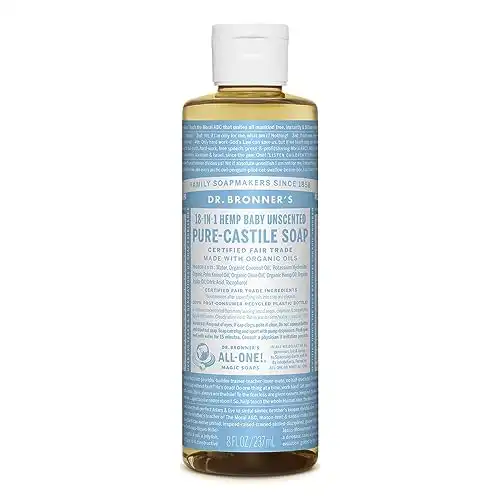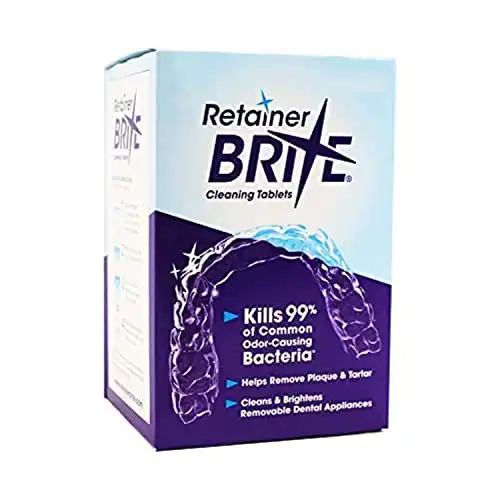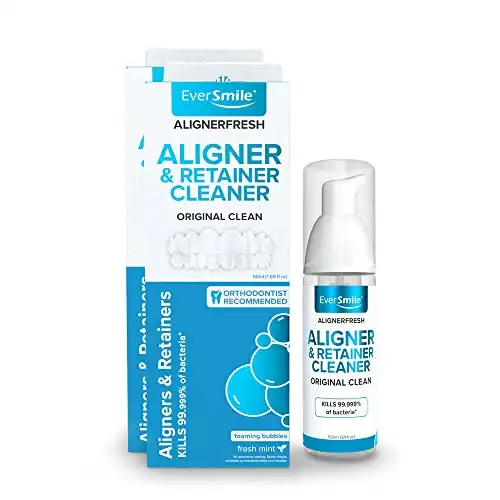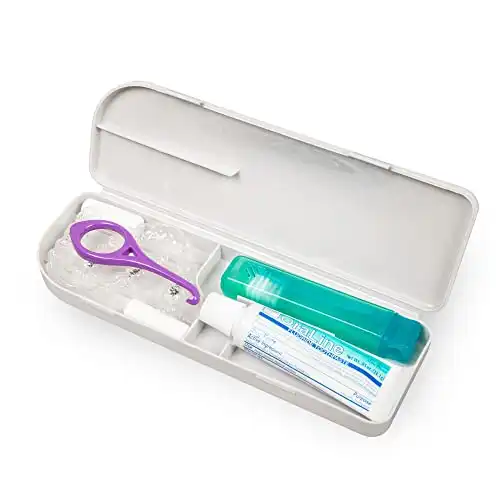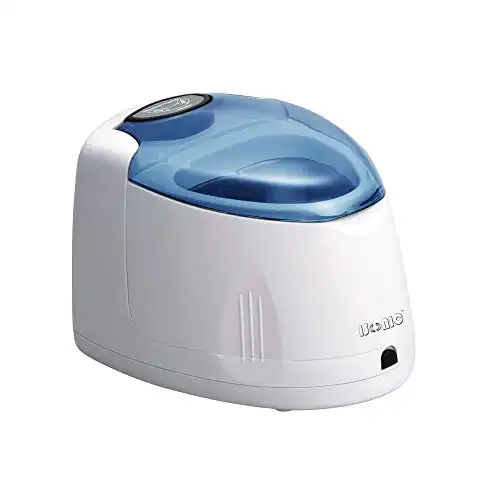Photo by Diana Polekhina on Unsplash
Many tweens and teenagers (and adults) wear plastic orthodontic retainers to correct their teeth alignment. While this type of orthodontic treatment is effective, how to clean plastic retainers and keeping them clean can be difficult.
If you’re a parent wondering the best way to make sure your tween or teen keeps their retainer clean, we’ll give you a few ways they can clean their retainer properly so that it stays free of bacteria and plaque buildup.
If done properly from the beginning, plastic retainers can be easily kept that way.
We will also discuss some common problems that can occur with clear retainers and how to fix them. So, if you’re curious about how to keep your plastic retainer looking and feeling its best, keep reading!
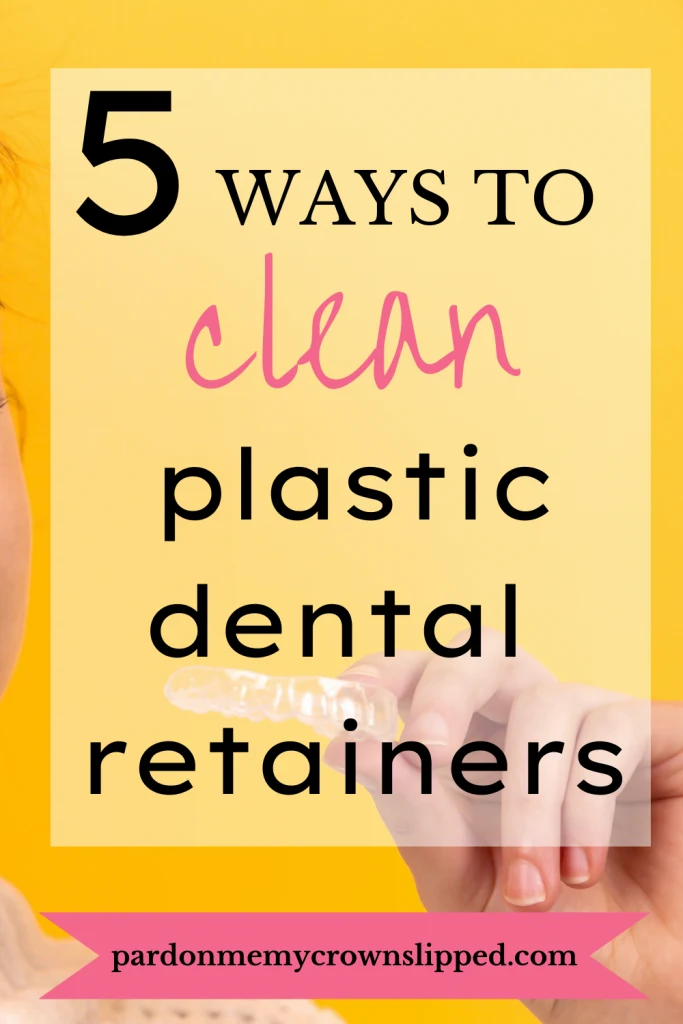
This post contains affiliate links. I will earn a commission at no additional charge to you if you make a purchase using my links. Click here to see my full disclosure policy.
Do I have to clean my retainer?
Yes, it is very important to learn how to clean plastic retainers and to do it regularly. Not only will this help keep it free of bacteria and plaque, but it will also help to prevent staining.
The best way to ensure you take care of your dental health as well as keep the retainer at its best is with daily cleaning.
Typically retainers are worn 24 hours a day at first, except when eating of course.
During this time, you should clean your retainer in the morning when first waking up. After being asleep all night, bacteria has built up in your mouth.
Give your retainer a thorough cleaning and then leave it to soak while eating breakfast. Then after brushing your teeth, rinse it off and put your clean retainer back in.
During meal periods, it’s best to keep your retainer in its case. Clear retainers make them easy to misplace. After meals, if possible brush your teeth or at the very least give your mouth a good rinsing before putting the retainer back in.
Before bed, a good rinsing after you brush your teeth is always a good idea.
If you have graduated to only wearing your retainer at night, give it a good cleaning before putting it away. If it was put away properly, then you need only follow up with a good rinsing before putting it back in your mouth for the night.
What are some common problems with retainers?
There are a few common problems that can occur with retainers. These include:
- Retainers can become stained if they are not cleaned regularly.
- If you don’t clean your retainer properly, bacteria can build up on it and cause bad breath.
- If you don’t wear your retainer regularly, your teeth may start to move back into their original position. If it occurs too often, the retainer will not fit.
Risk of not cleaning your retainer
Your retainer will keep collecting bacteria, plaque, and tartar from your mouth while you wear it. Over time, it may even start to smell or taste funny if you don’t clean it often enough.
More importantly, retainers can harbor dangerous bacteria. While many bacteria are normally found in the mouth, when too many build up, they can cause infection or illness.
How to clean your retainer
There are some differences in cleaning methods depending on the type of retainer you have.
Different types of retainers
There are two kinds of removable retainers: Hawley and clear plastic retainers.
Hawley retainers
Also called wire retainers, these are removable retainers made of thin metal wire and plastic or acrylic shaped to fit the roof of your mouth or along the inside of your lower teeth. The attached metal wire runs across the outside of your teeth to maintain alignment.
Clear plastic retainers
These are removable retainers that are molded to perfectly fit the new position of your teeth. They’re also called molded retainers.
Fixed, or bonded, permanent retainers
These types of retainers are attached to the back of your teeth and cannot be removed. In order to clean them, you will need to use a floss threader to floss around the retainer. You can also brush your retainer with a toothbrush and toothpaste. If you have any questions about how to properly care for your fixed retainer, be sure to ask your orthodontist.
The Best Way to Clean Your Retainer
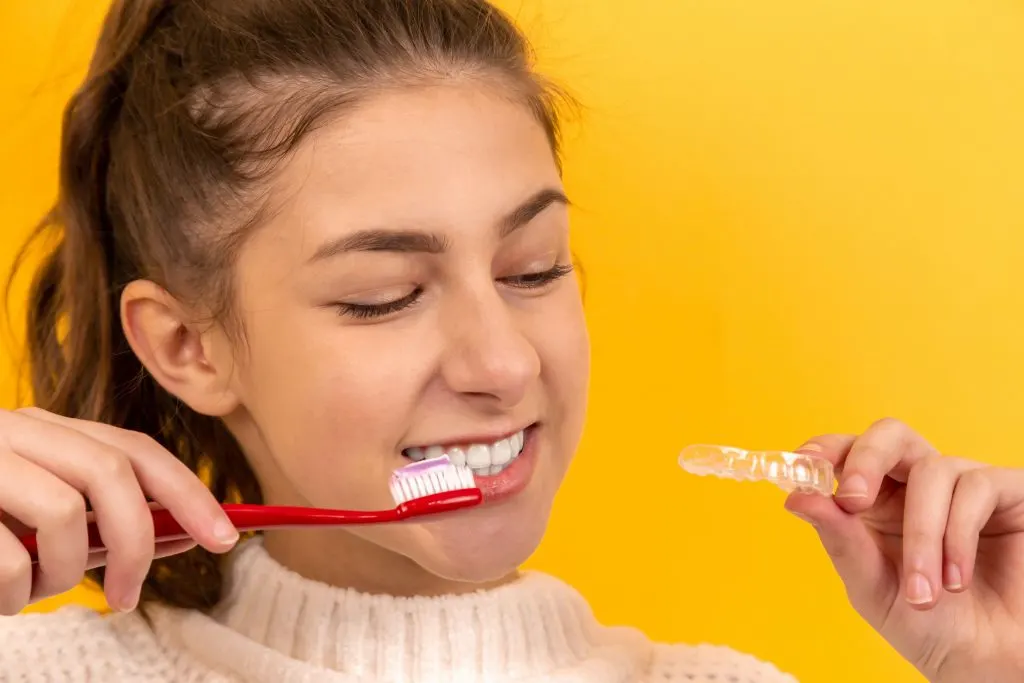
The best way to keep your retainer clean is to keep your mouth clean before wearing your retainer. This is because food particles and bacteria can build up on the retainer, causing
You can help keep your retainer clean by properly brushing your teeth before putting your retainer back in. Since eating on the go happens, giving your mouth a good rinse with clean water will help.
While you may think the best way to keep your retainer clean is to brush it with toothpaste, it’s actually not a good way at all. Toothpaste is too abrasive and can actually harm your retainer. It will scratch it and eventually give it a cloudy appearance.
Home Remedies for Cleaning Retainers
Here are four home remedy methods for keeping your retainer sparkling clean. Using one or all of these options will help to ensure your clear plastic retainer lasts as long as possible while making sure any harmful bacteria stay away.
How to Clean Plastic Retainers with Baking Soda
Baking soda can be used as a disinfectant that can control bacteria without harming the mouth.
Baking soda is a safe, all-purpose disinfectant. It may also help whiten retainers that have yellowed. Baking soda controls bacteria without harsh chemicals and can prevent a retainer from developing pH imbalances that harm the mouth.
To clean your retainer with baking soda, you will need:
- 2 tablespoons lukewarm water
- 2 tablespoons baking soda
- A soft-bristled toothbrush
Directions:
- Mix together the baking soda and water to form a paste
- Dip your toothbrush in the paste and scrub your retainer
- Rinse your retainer well
How to Clean Plastic Retainers with Castile Soap
Castile soap is less toxic than many other cleaning products. People can make their own with a solution of olive oil and coconut soap, but castile soap is readily available at most stores.
To clean your retainer with castile soap, you will need:
- 1 cup of warm water
- 1 teaspoon castile soap
- A soft-bristled toothbrush
Directions:
- Mix together the water and castile soap to form a lather
- Dip your toothbrush in the lather and scrub your retainer
- Rinse your retainer well
How to Clean Plastic Retainers with White Vinegar
White vinegar is a gentle disinfectant that can remove odors and residues.
To clean your retainer with vinegar, you will need:
- 1/2 cup white vinegar
- 1/2 cup warm water
- A soft-bristled toothbrush
Directions:
- Mix together vinegar and water
- Soak the retainer in the solution for about 20 minutes
- Scrub with toothbrush
- Rinse thoroughly afterward
How to Clean Plastic Retainers with Hydrogen Peroxide
Hydrogen peroxide will kill some bacteria, but will not remove plaque build-up.
To clean your retainer with hydrogen peroxide, you will need:
- 1/2 cup of warm water
- 1/2 cup 3% hydrogen peroxide
- A soft-bristled toothbrush
Directions:
- Mix together the water and hydrogen peroxide to form a solution.
- Soak your retainer in the hydrogen peroxide solution for 30 minutes
- Dip your toothbrush in the solution and scrub your retainer
- Rinse thoroughly
Other Ways to Clean Your Retainer
You can choose to purchase a ready-made solution to clean your retainer. Be sure to follow instructions for using them. Only use cleaners that are marketed for your retainer. Using something different can result in damage to your dental appliance.
How to Clean Plastic Retainers with Denture Tablets
You may have thought you could substitute denture tablets for retainer cleaners. This is not recommended since denture tablets are formulated specifically for dentures that are made from acrylic and porcelain. Clear plastic retainers will turn yellow if you consistently use denture tabs.
How to Clean Plastic Retainers with Retainer Tablets
There are a few retainer cleaners available that are specifically designed to keep your retainer fresh and clean. We like this brand of retainer tablets.
Proper Care of Your Retainer
1. Avoid heat
Never use hot water, a dishwasher, or a microwave to clean your retainer. The thin plastic will change shape or even melt. Forgetting it in a hot car may affect it too.
2. Avoid chemicals
Never use harsh chemicals on your retainer. Mild soap or solutions designed specifically for plastic retainers are best.
3. Give it a good soak
Some cleaning agents should only be used for a certain amount of time. You also want to be sure you’ve let your retainer soak long enough to kill any dangerous bacteria and help keep good dental health. Be sure to go over directions for cleaning your dental appliances, retainers with metal, like a Hawley, shouldn’t soak for too long.
4. Clean your case
The retainer case can also become a breeding ground of bacteria. Your retainer sits there while it’s not in your mouth. Chances are you didn’t clean your dirty retainer before putting it into the case. Making sure to give the case a thorough cleaning at least once a week is a good idea. Be sure the case and the retainer are dry. Moisture and other germs can still build up.
5. Be responsible for where you leave it
Be sure to take good care of your retainer. Eating with your retainer is never a good idea. Always keep it in the retainer case when it’s not in your mouth. It’s too easy to become distracted and throw it away if wrapped in a napkin. Not only does the case make it more visible, but it also keeps it from getting other germs on it from surfaces.
Pets seem to be attracted to retainers. Keep your pet and your retainer safe by keeping it out of harm’s way.
Two of my kids have retainers. Even though it’s very important to wear your retainer as directed by your orthodontist, I always asked my kids to leave their’s at home when having a sleepover. Unless they would be without it for more than 2 nights, this avoided issues with possible lost retainers.
6. Replace as needed
If your retainer changes shape, cracks, or otherwise doesn’t fit correctly it’s time to get a new retainer
How to Keep Your Retainer Clean
- Rinse it off after eating and before putting it back in
- Brush your teeth before putting the retainer in
- Soak it in a retainer cleaner or your own solution
- Clean it with a soft-bristled brush that’s dedicated to cleaning only your retainer
- Rinse it off and air dry
- Store it in a moisture-free container
Does your retainer smell?
If it does this means odor-causing bacteria have built up. Cleaning the retainer every single day will help prevent this bad smell, as well as a potential illness caused by putting a dirty appliance into your mouth!
Is your retainer covered in a hard white film?
This white film is plaque, the same stuff you brush off your teeth. If left on the retainer it can harden up to become tartar that is virtually impossible to clean off.
I hope these ideas for how to clean plastic retainers were helpful. Now if you can just keep your teen from losing it! 😉🤞
How do you clean clear plastic retainers?
Clear plastic retainers can be cleaned in a variety of ways. Baking soda, vinegar, Castille soap, and cleaners made specifically for cleaning retainers are best. Be sure to rinse before putting back into your mouth. Never use hot water or harsh chemicals like bleach, they will ruin the retainer.
How often should you wash your plastic retainer?
Ideally, your plastic retainer should be cleaned at least once per day. Bacteria and plaque build up in your mouth and on your retainer causing odors leading to bad breath. Use a solution of warm water and vinegar to kill bacteria. Then rinse before putting back into your mouth.
What is the white stuff on my plastic retainer?
If retainers are not properly cleaned, bacteria will build up and result in calcium deposits, plaque, and tartar. These are very difficult if not impossible to remove if left for too long.
Should I soak my plastic retainer?
Yes, you should soak your retainer at least once per week in a solution of half white vinegar and half lukewarm water for 20 minutes. You can also choose to soak for 30 minutes in a solution of equal parts 3% hydrogen peroxide and lukewarm water. Either option will help with bacteria but only the vinegar will help with the build-up of plaque. Be sure to rinse before putting back into your mouth.
How to clean plastic retainers with plaque
Soak your retainer in a solution of half white vinegar and half lukewarm water for 20 minutes. Then scrub with a soft-bristled toothbrush. Be sure to rinse before putting back into your mouth.
Can I soak my retainer in vinegar overnight?
A good 20-minute soak is more than sufficient to properly clean your retainer. Be sure to rinse before putting back into your mouth.
Can I clean my retainer with toothpaste?
No. Toothpaste is too abrasive for use on a plastic retainer. It will scratch and become cloudy.

